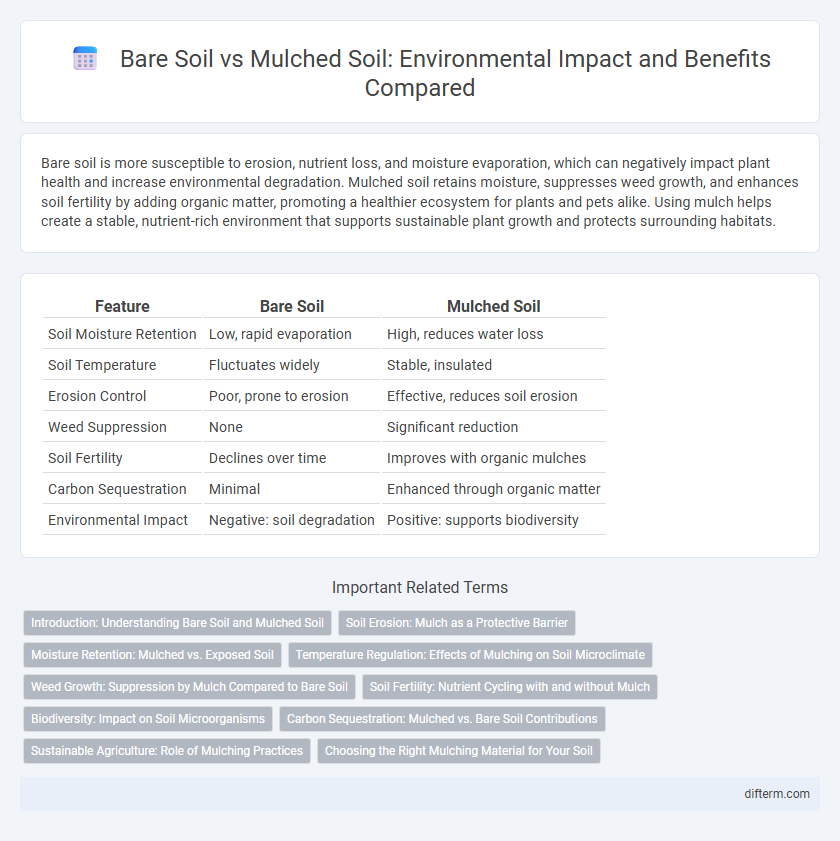Bare soil is more susceptible to erosion, nutrient loss, and moisture evaporation, which can negatively impact plant health and increase environmental degradation. Mulched soil retains moisture, suppresses weed growth, and enhances soil fertility by adding organic matter, promoting a healthier ecosystem for plants and pets alike. Using mulch helps create a stable, nutrient-rich environment that supports sustainable plant growth and protects surrounding habitats.
Table of Comparison
| Feature | Bare Soil | Mulched Soil |
|---|---|---|
| Soil Moisture Retention | Low, rapid evaporation | High, reduces water loss |
| Soil Temperature | Fluctuates widely | Stable, insulated |
| Erosion Control | Poor, prone to erosion | Effective, reduces soil erosion |
| Weed Suppression | None | Significant reduction |
| Soil Fertility | Declines over time | Improves with organic mulches |
| Carbon Sequestration | Minimal | Enhanced through organic matter |
| Environmental Impact | Negative: soil degradation | Positive: supports biodiversity |
Introduction: Understanding Bare Soil and Mulched Soil
Bare soil exposes the ground to erosion, moisture loss, and temperature fluctuations, negatively impacting plant growth and soil health. Mulched soil, covered with organic or inorganic materials, enhances moisture retention, reduces weed growth, and stabilizes temperature, promoting sustainable agriculture and environmental conservation. Understanding the differences between bare and mulched soil is essential for effective land management and soil preservation strategies.
Soil Erosion: Mulch as a Protective Barrier
Mulched soil significantly reduces soil erosion by acting as a protective barrier that cushions the impact of raindrops and slows surface runoff. Bare soil is highly susceptible to erosion, leading to nutrient loss and diminished soil structure. Applying mulch enhances soil stability, retains moisture, and promotes healthier plant growth by maintaining a protective cover.
Moisture Retention: Mulched vs. Exposed Soil
Mulched soil retains up to 50% more moisture compared to exposed bare soil, reducing evaporation and promoting healthier plant growth. Organic mulches improve soil structure and increase water infiltration rates, while bare soil is prone to rapid drying and erosion. Consistent moisture retention in mulched soil supports microbial activity essential for nutrient cycling.
Temperature Regulation: Effects of Mulching on Soil Microclimate
Mulched soil maintains more stable temperatures by insulating against extreme heat and cold, promoting optimal root development and microbial activity. Bare soil experiences greater temperature fluctuations, which can stress plants and reduce nutrient availability. Mulching also helps retain soil moisture, further contributing to a favorable microclimate for plant growth.
Weed Growth: Suppression by Mulch Compared to Bare Soil
Mulched soil significantly reduces weed growth by blocking sunlight and creating a physical barrier that inhibits weed seed germination, unlike bare soil where weed seeds are more exposed to favorable conditions for sprouting. Organic mulches also enhance soil moisture retention and temperature regulation, further discouraging weed establishment. Studies show mulched areas can experience up to a 90% reduction in weed density compared to bare soil environments.
Soil Fertility: Nutrient Cycling with and without Mulch
Mulched soil enhances soil fertility by promoting efficient nutrient cycling through moisture retention and organic matter decomposition, which supports microbial activity and nutrient availability. Bare soil experiences faster nutrient depletion due to increased erosion and reduced organic input, resulting in lower soil structure quality and fertility over time. Incorporating mulch improves nutrient retention, reduces leaching, and fosters a sustainable environment for plant growth.
Biodiversity: Impact on Soil Microorganisms
Mulched soil enhances biodiversity by providing a protective layer that maintains moisture and temperature, fostering a habitat rich in beneficial soil microorganisms such as bacteria, fungi, and earthworms. Bare soil, exposed to temperature extremes and erosion, often exhibits reduced microbial diversity and activity, limiting nutrient cycling and soil health. Increased microbial biodiversity in mulched soils improves soil structure, organic matter decomposition, and plant growth support.
Carbon Sequestration: Mulched vs. Bare Soil Contributions
Mulched soil significantly enhances carbon sequestration by increasing organic matter content and reducing soil respiration losses compared to bare soil. The presence of mulch promotes microbial activity and stabilizes carbon in the soil matrix, leading to higher long-term carbon storage. Bare soil, exposed to erosion and oxidation, releases more CO2, thus contributing less effectively to carbon sequestration efforts.
Sustainable Agriculture: Role of Mulching Practices
Mulching practices enhance sustainable agriculture by improving soil moisture retention, reducing erosion, and suppressing weed growth compared to bare soil. Organic mulches contribute to soil fertility through gradual decomposition, promoting microbial activity and nutrient cycling vital for crop health. The implementation of mulched soil techniques supports long-term soil structure stability, reducing the need for chemical inputs and conserving natural resources.
Choosing the Right Mulching Material for Your Soil
Selecting the appropriate mulching material depends on soil type, climate, and plant needs, with organic mulches like wood chips improving soil fertility and moisture retention, while inorganic options like gravel provide long-term weed control. Mulched soil enhances microbial activity and nutrient availability compared to bare soil, reducing erosion and temperature fluctuations. Proper mulching material optimizes soil health, promotes sustainable plant growth, and minimizes water usage for environmental benefits.
bare soil vs mulched soil Infographic

 difterm.com
difterm.com